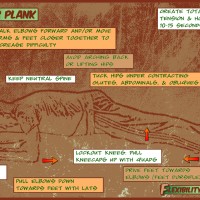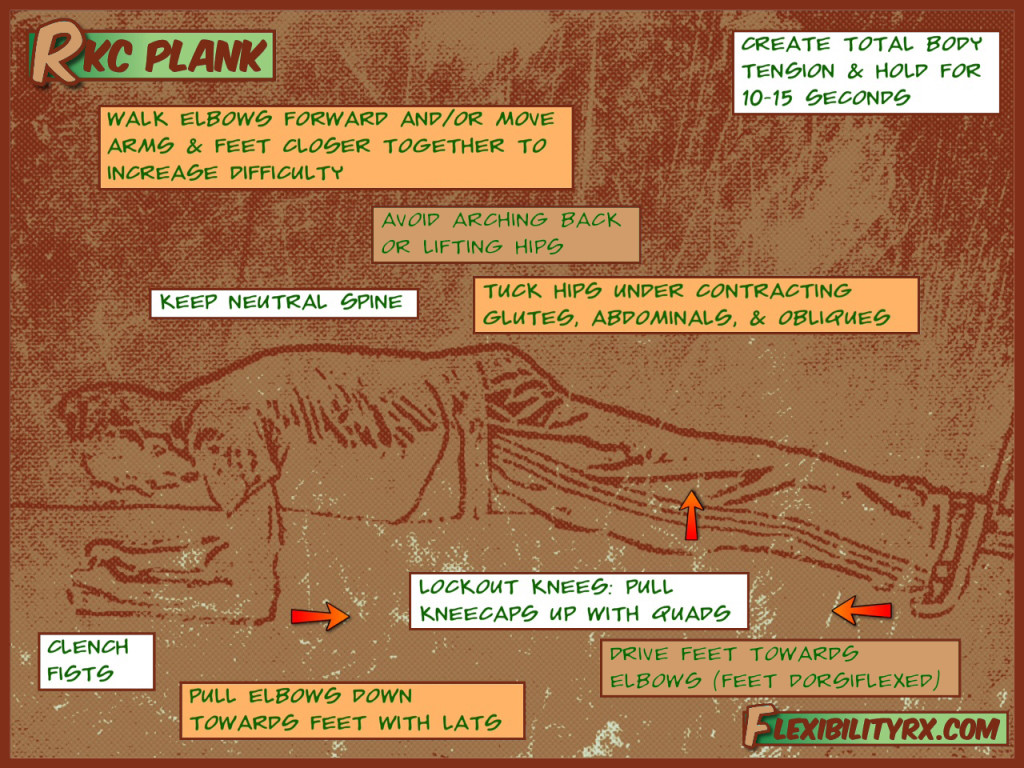
The RKC Plank
Almost all athletes are familiar with the front plank, however, very few gym members have heard of the RKC plank. The traditional front plank is great for learning how to align and stabilize the spine. Once an athlete is able to hold a regular plank with good form – there is a more challenging plank that has many benefits over the traditional version.
Hardstyle Plank for Total Body Tension
Pavel Tsatsouline started the Russian Kettlebell Challenge (“RKC”), an advanced kettlebell training certification, with Dragon Door in 2001. In 2012 Pavel left RKC and formed a new company called StrongFirst. A major tenet of kettlebell training is a concept called whole body tension. While regular planks are held for a prolonged period of time to improve endurance – the RKC plank is held for a brief period of time to increase activation of the abdominals, glutes, and quadriceps – to increase strength.
The expression of maximal strength is the foundation for powerlifting and Olympic lifting movements like the squat, deadlift, clean & jerk, and snatch.
The plank is one of the most incorrectly performed exercises in the gym. Spinal alignment and diaphragmatic breathing are two key points of the plank. Before progressing to the RKC Plank here are some common plank mistakes.
Common Plank Mistakes
#1: Arching the Low-Back
#2: Letting the Head Hang
#3: Hips Too High (Like a DownDog)
“When the upper back is rounded, the main focus of the movement is on the neck and shoulders versus the abs. When the butt is sticking up, the main stabilizers are the lumbar erector spinae and hip flexor complex, not necessarily the entire core.” – Dean Somerset
Components of the RKC Plank
#1: Posterior Pelvic Tilt (Glutes)
#2: Hollow Body Position (Drive Elbows Towards Feet & Feet Towards Elbows)
#3: Extended Knees (Quad Activation)
#4: Ankle Dorsiflexion (Anterior Chain Activation)
#5: Clenched Fists (Scapular Stability)
#6: Progression to Longer Plank (Elbows in Front of Shoulders)
Bret Contreras points out that,
The RKC plank has 4x more abdominal, 3x more external oblique, and 2x more internal oblique activity than the standard plank. The hardstyle plank also has much more glute max activity, teaches proper hip mechanics to prevent lumbar hyperextension, and trains the glute max to stabilize the SI-joint during hip extension movements.
Dean Somerset explains,
“A plank should be a very intense, full body contraction that lasts only 8-10 seconds, not some bastardized version of a yoga pose you sustain for 10 minutes…Some exercises are direct representations of a plank position, so hitting up a plank beforehand is very helpful, such as planks before push-ups and side planks before lunges.”
A plank is a perfect example of total body tension and co-contractive forces. It’s a battle of near-maximal contractile strength from all areas (shoulders, abs, glutes, low back and quads) to produce a steel beam in human form, able to withstand any external forces.
– Kevin Kula, “The Flexibility Coach” – Creator of FlexibilityRx™ – www.FlexibilityRx.com
Related Resources
FlexibilityRx: The Plank Roll Exercise (link)
How to REALLY Do a Perfect Plank | RKC School of Strength (link)
Bret Contreras: The RKC Plank (link)
Dean Somerset (T-Nation): Superhuman Planks (link)
Tags: core stability, rkc plank, russian kettlebell challenge

Leave A Reply (No comments so far)
You must be logged in to post a comment.
No comments yet